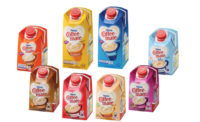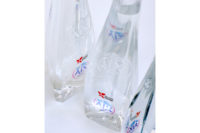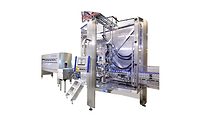Personalized packaging grows in beverage industry
Customization, innovation grows due to demand

Sidel’s new rightweight approach to lightweight bottle design ensures bottles are lighter while they stay attractive, protect beverages and lead to high consumer satisfaction. (Image courtesy of Sidel)



If the beverage industry were a baseball team, there would be a lot of different players, from water to wine, spirits to soda and the juices, coffee and teas in between. One thing that each player would have in common is that they must adapt to what consumers want because one thing is sure: consumers want their beverages customized. Just walk into Starbucks to hear a certain editor’s coffee order: Grande soy, 2 pumps sugar-free cinnamon dolce latte, extra hot, no whip (what can I say; it’s how I like it). The options are endless for customization. The more custom and personalized the drink, the more indulgent that beverage appears. According to Chicago-based design firm Landor, 2015 is all about the individual, not the masses.
Thomas Ordahl, Landor’s chief strategy officer, says, “The brands of 2015 will be more agile, changing and adapting to meet the specific needs of individual consumers. Whether it’s creating custom packaging or using input from social media to improve a product, companies will embrace the power of one like never before.”
The Coca-Cola Co., Atlanta, was ahead of the curve with its Share a Coke campaign, which launched for the first time last year, and brought personalized packaging to its consumers. People love personalized items, from jewelry to license plates, and The Coca-Cola Co. capitalized on this by creating personalized bottles. The campaign featured common names and terms of endearment to bring the drinking experience closer to home. The brand printed 250 of the most popular names among teens and millennials on 20-ounce bottles in its first year of the campaign. The company reintroduced the campaign this year offering more names on more bottles.
A unique experience
To create a personal consumer experience with a brand through smartphones, Avery Dennison, Niles, Ill., has launched the DirectLink solution. NFC technology and the DirectLink solution quickly links consumers to a brand’s message directly from the product to the consumer’s smartphone. The DirectLink solution is all about bringing a brand’s message to the consumer in a contact-less way. Consumers gain immediate access to user friendly content. Simply hold an NFC-enabled smartphone over the tag and the information is automatically loaded to the device. Information like videos, contests, surveys and coupons are all options. The tag itself is hidden within the label so that current design is not disturbed. For the wine industry, DirectLink can deliver fun information like vineyard details, pairing suggestions and recipes. It also allows for authenticity tracking and offers a farm to table approach for wine.
Sometimes an experience isn’t always as hands-on as using a smartphone to garner additional product details, sometimes it is just smiling and relaxing into the package’s beauty. One Swedish startup brand, NOA Potions, has captured a lot of attention with the release of its relaxation drink.
NOA Potions won the world’s largest beverage contest, World Beverage Innovation Awards in November, with its anti-stress beverage NOA Relaxation.
Relaxation drinks are fairly new to the beverage industry, but are gaining in popularity. NOA Relaxation boasts that it will help reduce stress and increase mental capacity and the bottle’s whimsical feel only solidifies these claims. The pastel colors and floral graphics lend it to a natural, ethereal appearance.
Beverage packaging has a unique job, not only must it protect the liquid inside, but it must convey the brand’s story and appeal to the consumer. Today’s consumers are buying their beverages differently. The days of stocking up on the family’s favorite drink at a club store are dwindling. While the occasion to do just that is still relevant today what is more relevant is the quick decision purchase.
Jill Ahern, consulting services senior director for Packaging Technology Integrated Solutions at HAVI Global Solutions, Downers Grove, Ill., says that there is a rise in the popularity of single-serve and quick grab-and-go items. She says that buying ahead or in bulk is declining; consumers buy what they need for the moment. Because of this, the package must be portable and convenient as consumers adopt a convenience store approach to consumption. Packagers must create packaging that conveys the benefits of the beverage, or entices a consumer looking for an indulgent product. Taking it a step further, some packaging has even been designed ergonomically to fit perfectly in consumers’ hands to make the grab-and-go experience even more comfortable.
Eco-conscious packaging still top of mind
Disposability is still on consumers’ minds, according to Ahern. More than ever we are aware of recyclability, recycled materials and the idea of lightweighting. Switzerland-based Sidel’s RightWeight bottle addresses consumer concerns about packaging waste. The concept bottle weighs 34 percent less than the average commercial bottle and achieves 32 percent more top-load performance than the lightest commercial bottle, resulting in cost savings, according to Sidel data. This approach ensures bottles are lighter but also stay attractive, protect beverages, and lead to high consumer satisfaction.
The bottle, designed for still water, uses less energy during production and still delivers a good consumer experience, as the bottle’s integrity is not compromised through the lightweighting process.
Since grade school, we have been taught about the 3 R’s: reduce, reuse and recycle. This idea is still very much prevalent within the packaging industry.
Novelis, Hinsdale, Ill., announced a new commitment to convert its entire beverage can body sheet production to its evercan sheet by the end of 2017. Evercan is the world’s first certified high-recycled content aluminum for beverage cans. This commitment means that the all can body sheet produced by Novelis will be certified 90 percent recycled content, compared to the global industry average of 50 percent.
To encourage broad adoption across the market, Novelis will assist other aluminum manufacturers by sharing knowledge of the process to certify high-recycled content beverage sheets using the methodology of Scientific Certification Services (SCS), a recognized leader in environmental auditing that certifies evercan’s
high-recycled content.
The shift is sure to satisfy consumers as today more than ever they are paying attention to the materials used in some of their favorite packages. According to a survey by Forum for the Future, 62 percent of consumers say they would feel negatively toward brands that do not use sustainable packaging and 90 percent are prepared to boycott brands they consider to be acting irresponsibly.
Beverage packaging today aims to please on several levels: aesthetics, eco-conscious, functional, customized, unique and interactive. The pressure is on to hit the ball out of the park and to deliver consumers a home run.
Beverage Packaging study shows growth opportunities
According to PMMI’s Beverage Packaging Market Assessment, published in September, the beverage market in the United States is expected to reach a value of $26.3 billion by 2015. Bottles are still the top choice for packaging, making up 55 percent of the market. Plastic is expected to remain the most popular packaging material for the foreseeable future, making up 40 percent of the market’s material use. And although they suffered from a drop in soft drink sales, aluminum cans are picking up steam as other beverage categories — such as energy drinks and microbrews — are more than making up for the lost volume. Flexible pouches have experienced the slowest growth, but many respondents still anticipate increased adoption of flexible beverage packaging down the road. The key to that, the report says, would be products geared to consumers accustomed to beverages, such as juice, in pouches. The report listed the challenges and trends in packaging for the beverage market, which some revolve around portion sizes, package dimensions and attributes contributing to brand differentiation.
Looking for a reprint of this article?
From high-res PDFs to custom plaques, order your copy today!








